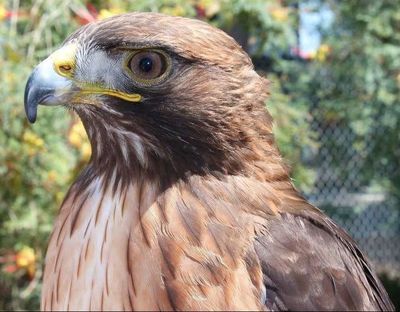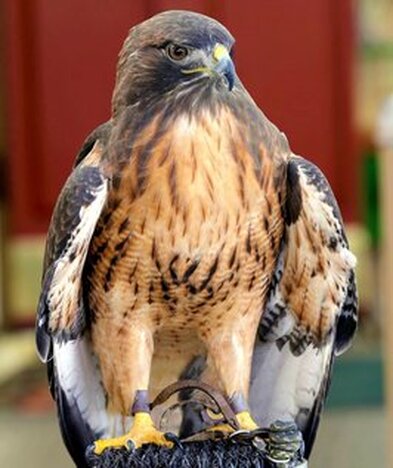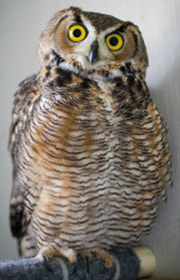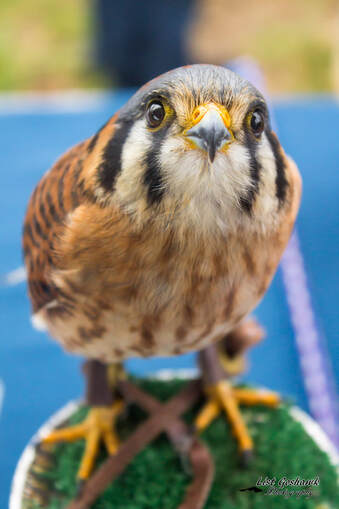OUR RAPTOR AMBASSADORS
Owls, eagles, falcons, condors, hawks, ospreys, kites, and vultures are all raptors. Raptors have strong grasping feet with sharp talons for catching and holding prey. Their hooked upper beak tears and kills prey, and their binocular vision provides depth perception for hunting. Raptors help maintain the balance of nature by controlling rodents, reptiles, insects and other prey. State and Federal laws protect raptors, and provide permits for lawful possession and care of raptors.
All of our raptor ambassadors are non-releasable. Their injuries prevent them from surviving in the wild. We train them to be comfortable on the fist in classroom and outdoor settings. Due to their extensive injuries at a young age, many of our ambassadors are imprints. Imprints are accustomed to people and unable to learn how to hunt or to fear the unfamiliar.
All of our raptor ambassadors are non-releasable. Their injuries prevent them from surviving in the wild. We train them to be comfortable on the fist in classroom and outdoor settings. Due to their extensive injuries at a young age, many of our ambassadors are imprints. Imprints are accustomed to people and unable to learn how to hunt or to fear the unfamiliar.
|
RED-TAILED HAWK - HENRIETTA: I go by Hank and I came to Orange County Bird of Prey Center as a fledgling in 2010 with a fractured right leg from the Tejon Ranch area. I have recuperated, but I cannot be released back into the wild. Therefore, I have become one of the Center's beloved education ambassadors.
Red-tailed Hawks are the most common and widespread raptor in North America. Males are 80% the size of females, despite our matching plumage. Immature Red-tailed Hawks do not have a red tail. We are usually soaring in the sky, scouring for our prey: small mammals, rodents, reptiles, amphibians and insects. Our brood size is 2-3. Although we are raptors, we still have to watch out for our natural predators, including Great Horned Owls, Eagles, Peregrine Falcons, and dogs! I love to go out to visit the public. Click on my story to see how those days go. |
|
RED-TAILED HAWK - DULCE: My name is Dulce and I hatched in 2007. My history is a bit unknown, but I am clearly an imprint. I hung out with the wrong crowd in my younger days (in my case - people) and never learned how to be a proper Red-tailed Hawk. I’m missing out on being the most common and widespread Buteo in North America: living in mountains, deserts, prairies and on the coast. Buteo jamaicensis sexes are alike in plumage, but females are usually larger than males.
People often see Red-tailed Hawks soaring or perching on tree tops or poles, looking for their prey: small mammals, rodents, reptiles, amphibians, and insects. We nest in tall trees or on ledges or cliffs and usually have 2-3 young. Before I found my home at OCBPC, I visited two other licensed facilities. The nice folks at these places do their best to find an appropriate home for the "non-releaseables." We require a lot of resources, so most of these volunteer, non-profit places can only afford a few permanent residents. |
|
GREAT HORNED OWL - TWEEK: I'm Tweek. In 2012, when I was a hatchling, I fell out of the nest and landed on my head. I am dain bramaged (suffered neurological injuries). If you can believe it, I was just a puff ball of feathers that almost didn't make it! Thanks to the great care at the hospital, I am now a full-fledged OCBPC ambassador.
Although we are nocturnal, in the winter, we can be diurnal. Our unsuspecting prey cannot hear us swoop down and catch it due to our muffled flight. If you do not see us in the dark, you may recognize our stereotypical hoots. We do not have many predators but still have to be wary of other Great Horned Owls and mankind. |
|
AMERICAN KESTREL - QUEST: A 2017 female hatchling, I could be flying free if someone had taken me to Serrano Animal and Bird Hospital. I was injured as a fledgling and went to a vet hospital that doesn't specialize in raptors. Unfortunately, the vet tech that cared for me didn't know proper raptor care and he imprinted me on to humans. Although I recovered physically, I can never be released because I'm not afraid of anything and don't know how to hunt.
As the smallest North America raptor, we show color sexual dimorphism, which is the differences between males and females. I have beautiful brown wings, a “dashed” chest, and a barred brown tail. Males of my species have blue-grey wings, a spotted chest, and a reddish tail with a white tip. Although it isn’t as cool as killing a juicy plump mouse, I eat a lot of insects along with small rodents and reptiles. It’s funny to watch my kind chase grasshoppers! |






